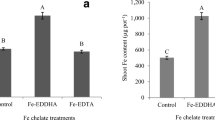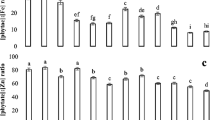Abstract
Iron availability to plants is often limited when soil pH is 7 or higher. In C rich, but Fe limiting environments, microorganisms may produce organic chelators that complex Fe and increase its availability to plants. Seedlings of soybean (Glycine max L.) and oat (Avena sativa L.) plants, with Fe-efficient or inefficient uptake mechanisms, were grown in an Fe free nutrient solution at pH 7.5. Experiments (using a complete factorial design) were conducted in which these seedlings were transferred to a fresh nutrient solution and treated with Fe sources (FeCl3, FeEDDHA, and Fe complexed with chelators produced by compost microorganisms (CCMs) after their enrichment in an Fe free, glucose medium), Fe concentrations (0 and 6.7 μM) and antibiotic (0 and 100 mg streptomycin L-1). Dry weight of soybean plants and Fe uptake were significantly (P ≤ 0.05) higher when Fe was supplied as 59FeCCM than as59 FeCl3 and similar to when Fe was supplied as59 FeEDDHA. Dry weight of the Fe-inefficient Tam 0-312 oat cultivar was also significantly higher when Fe was supplied as FeCCM. Fe uptake by oat, when supplied as 59FeCCM, was twice that for59 FeEDDHA and 59FeCl3. Chlorophyll concentration in plants supplied with FeCCM and FeEDDHA was significantly greater (P ≤ 0.05) than in minus Fe control plants and in FeCl3 supplied plants. Activities of catalase and peroxidase, measured as indicators of Fe nutrition in soybean and oats, were generally increased when Fe was supplied with FeCCM as compared to the other Fe sources. The experimental conditions in which the CCMs were produced are similar to those in soil after amendment with manures or other readily available organic materials. These CCMs can bind with Fe, even under slightly alkaline conditions, and effectively improve Fe nutrition of soybean and oat.
Similar content being viewed by others
References
Altas R M 1993 Microbiological Media. CRC, Boca Raton, Florida, USA. 529 p.
Bar-Ness E, Chen Y, Hadar Y, Marschner H and Römheld V 1991 Siderophores of Pseudomonas putida as an iron source for dicot and monocot plants. Plant Soil 130, 231–241.
Becker J O, Hedges R W and Messens E 1985 Inhibitory effect of pseudobactin on the uptake of iron by higher plants. Appl. Environ. Microbiol. 49, 1090–1093.
Bienfait H F, Briel W V D and Mesland-mul N T 1985 Free space iron pools in roots: Generation and mobilization. Plant Physiol. 78, 596–600.
Boehm M J, Madden L V and Hoitink H A J 1993 Effect of organic matter decomposition level on bacterial species diversity and composition in relationship to pythium damping-off severity. Appl. Environ. Microbiol. 59, 4171–4179.
Brown J C and Jolley V D 1989 Plant metabolic responses to iron-deficiency stress. A variety of mechanisms, grouped into two major strategies, make iron available from the soil. BioScience 39, 546–551.
Bruinsma J 1963 The quantitative analysis of chlorophylls a and b in plant extracts. Photochem. Photobiol. 2, 241–249.
Cline G R, Reid C P P, Powell P E and Szaniszlo P J 1984 Effects of a hydroxamate siderophore on iron absorption by sunflower and sorghum. Plant Physiol. 76, 36–39.
Crowley D E, Patrick Reid C P and Szaniszlo P J 1988 Utilization of microbial siderophores in iron acquisition by oat. Plant Physiol. 87, 680–685.
Crowley D E, Wang Y C, Reid C P P and Szaniszlo P J 1991 Mechanisms of iron acquisition from siderophores by microorganisms and plants. Plant Soil 130, 179–198.
Dekock P C, Commisiong K, Farmer V C and Inkson R H E 1960 Interrelationships of catalase, peroxidase, hematin, and chlorophyll. Plant Physiol. 35, 599–604.
Dick W A and McCoy E L 1993 Enhancing soil fertility by addition of compost. In Science and Engineering of Composting: Design, Environmental, Microbiological and Utilization Aspects. Eds. H A J Hoitink and H M Keener. pp 622–644. Renaissance Publications, Worthington, OH, USA.
Duijff B J, Kogel W J, Bakker P A H M and Schippers B 1994a Influence of pseudobactin 358 on the iron nutrition of barley. Soil Biol. Biochem. 26, 1681–1688.
Duijff B J, Bakker P A H M and Schippers B 1994b Ferric pseudobactin 358 as an iron source for carnation. J. Plant Nutr. 17, 2069–2078.
Frostegård C, Petersen S, Bååth E and Nielsen T H 1997 Dynamics of a microbial community associated with manure hot spots as revealed by phospholipid fatty acid analyses. Appl. Environ. Microbiol. 63, 2224–2231.
Guerinot M L and Yi Y 1994 Iron: Nutritious, noxious, and not readily available. Plant Physiol. 104, 815–820.
Hammerschmidt R, Nuckles E M and Kuc J 1982 Association of enhanced peroxidase activity with induced systemic resistance of cucumber to Colletotrichum legenarium. Physiol. Plant Pathol. 20, 73–82.
Han Z H, Wang Q and Shen T 1994 Comparison of some physiological and biochemical characteristics between iron-efficient and iron-inefficient species in the genus Malus. J. Plant Nutr. 17, 1257–1264.
Havir E A and McHale N A 1987 Biochemical and developmental characterization of multiple forms of catalase in tobacco leaves. Plant Physiol. 84, 450–455.
Isaac J B, Johnson W A 1985 Elemental analysis of plant tissue by plasma emission spectroscopy: collaborative study. J. Assoc. Off. Anal. Chem. 68, 499–505.
Johnson-Flanagan A M and Owens J N 1985 Peroxidase activity in relation to suberization and respiration in white spruce (Piceaglauca [Moench) (Voss) seedling roots. Plant Physiol. 79, 103–107.
Jolley V D and Brown J C 1989 Iron inefficient and efficient oat cultivars. II Characterization of phytosiderophore released in response to Fe deficiency stress. J. Plant Nutr. 12, 923–937.
Jurkevitch E, Hadar Y and Chen Y 1988 Involvement of bacterial siderophores in the remedy of lime-induced chlorosis in peanut. Soil Sci. Soc. Am. J. 52, 1032–1037.
Lindsay W L 1984 Soil and plant relationships associated with iron deficiency with emphasis on nutrient interactions. J. Plant Nutr. 7, 489–500.
Lindsay W L 1991 Iron oxide solubilization by organic matter and its effect on iron availability. Plant Soil 130, 27–34.
Lindsay W L and Schwab A P 1982 The chemistry of iron and its availability to plants. J. Plant Nutr. 5, 821–840.
Longnecker N 1988 Iron nutrition of plants. ISI Atlas of Science: Animal and Plant Sciences. pp 143–150.
Loper J E and Buyer J S 1991 Siderophores in microbial interactions on plant surfaces. Molec. Plant-micr. Inter. 4, 5–13.
Lytle C M, Jolley V D and Brown J C 1991 Iron-efficient and iron-inefficient oats and corn respond differently to iron-deficiency stress. Plant Soil 130, 165–172.
McCaslin B D, Davis J G, Cihacek L and Schluter L A 1987 Sorghum yield and soil analysis from sludge-amended calcareous iron-deficient soil. Agron. J. 79, 204–209.
Miller G W, Pushnik J C, Brown J C, Emery T E, Jolley V D and Warnick K Y 1985 Uptake and translocation of iron from ferrated rhodotorulic acid in tomato. J. Plant Nutr. 8, 249–264.
Neilands J B 1981 Iron absorption and transport in microorganisms. Annu. Rev. Nutr. 1, 27–46.
O'Sullivan M 1969 Iron metabolism of grasses: I. Effect of iron supply on some inorganic and organic constituents. Plant Soil 31, 451–462.
Parsa A A and Wallace A 1979 Organic solid wastes from urban environment as iron sources for sorghum. Plant Soil 53, 455–461.
Petersen S O, Nielsen T H and Henriksen K 1993 Direct measurement of oxygen microprofiles and distribution of phospholipid-P in a two-phase soil-manure system. Geoderma 56, 549–559.
Petersen S, Nielsen T H, Frostegård C and Olesen T 1996 O2 up-take, C metabolism and denitrification associated with manure hot-spots. Soil Biol. Biochem. 28, 341–349.
Prasad B 1981 Use of organic manure for correction of zinc and iron deficiency in maize plant grown in calcareous soil. J. Indian Soc. Soil Sci. 29, 132–133.
Press C M, Mahaffee W F, Edwards J H and Kloepper J W 1996 Organic by-product effects on soil chemical properties and microbial communities. Compost Sci. Util. 4, 70–80.
Raymond K N and Carrano C J 1979 Coordination chemistry and microbial iron transport. Acc. Chem. Res. 12, 183–190.
Römheld V 1987 Different strategies for iron aquisition by higher plants. Physiol. Plant. 70, 231–234.
Schwyn B and Neilands J B 1987 Universal chemical assay for the detection and determination of siderophores. Anal. Biochem. 160, 47–56.
Shenker M, Ghirlando R, Oliver I, Helmann M, Hadar Y and Chen Y 1995 Chemical structure and biological activity of a siderophore pnoduced by Rhizopus arrhizus. Soil Sci. Soc. Am. J. 59, 837–843.
Siegel B Z 1993 Plant peroxidase-an organismic perspective. Plant Growth Regul. 12, 303–312.
Sijmons P C, Kolattukudy P E and Bienfait H F 1985 Iron deficiency decreases suberization in bean roots through a decrease in suberin-specific peroxidase activity. Plant Physiol. 78, 115–120.
Skrensen P and Jensen E S 1995 Mineralization of carbon and nitrogen from fresh and anaerobically stored sheep manure in soils of different texture. Biol. Fertil. Soils 19, 29–35.
Smith P K, Krohn R I, Hermanson G T, Mallia A K, Gartner F H, Provenzano M D, Fujimoto E K, Geoke N M, Olson B J and Klenk D C 1985 Measurement of protein using bicinchoninic acid. Anal. Biochem. 150, 76–85.
Sørensen P and Jensen E S 1995 Mineralization of carbon and nitrogen from fresh and anaerobically stored sheep manure in soils of different textune. Biol. Fertil. Soils 19, 29–35.
Stevenson F J 1994 Humus Chemistry: Genesis, Composition, Reactions, 2nd edn. John Wiley & Sons, New York, New York, USA. 496 p.
Takagi S, Nomoto K and Takemoto T 1984 Physiological aspect of mugineic acid, a possible phytosiderophore of graminaceous plants. J. Plant Nutr. 7, 469–477.
Vose P B 1982 Iron nutrition in plants: A world overview. J. Plant Nutr. 5, 233–249.
Walter A, Römheld V, Marschner H and Crowley D E 1994 Iron nutrition of cucumber and maize: Effect of Pseudomonas putida YC 3 and its siderophore. Soil Biol. Biochem. 26, 1023–1031.
Wang Y, Brown H N, Crowley D E and Szaniszlo P J 1993 Evidence for direct utilization of a siderophore, ferrioxamine B, in axenically grown cucumber. Plant Cell Environ. 16, 579–585.
Yehuda Z, Shenker M, Römheld V, Marschner H, Hadar Y and Chen Y 1996 The role of ligand exchange in the uptake of iron from microbial siderophores by graminaceous plants. Plant Physiol. 112, 1273–1280.
Zhang J and Kirkham M B 1994 Drought-stress-induced changes in activities of superoxide dismutase, catalase, and peroxidase in wheat species. Plant Cell Physiol. 35, 785–791.
Author information
Authors and Affiliations
Rights and permissions
About this article
Cite this article
Chen, L., Dick, W.A., Streeter, J.G. et al. Fe chelates from compost microorganisms improve Fe nutrition of soybean and oat. Plant and Soil 200, 139–147 (1998). https://doi.org/10.1023/A:1004375430762
Issue Date:
DOI: https://doi.org/10.1023/A:1004375430762




